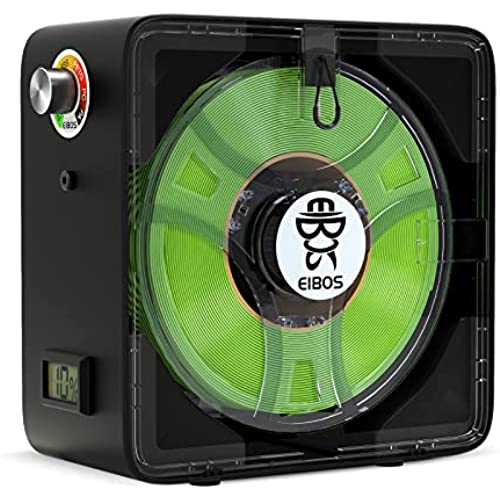
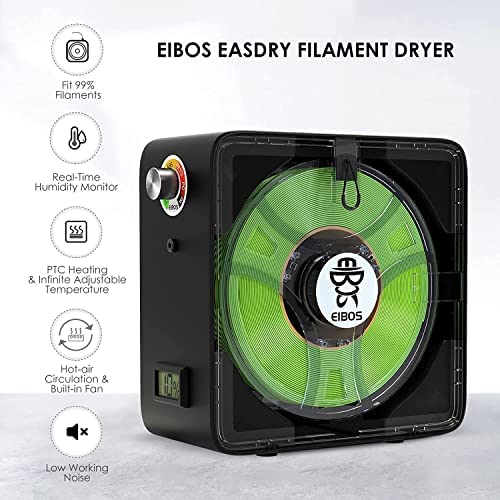
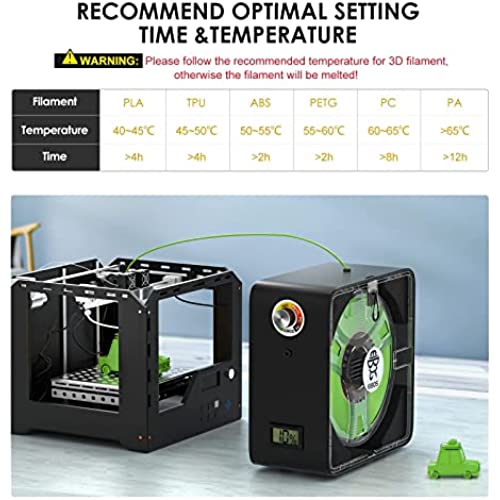
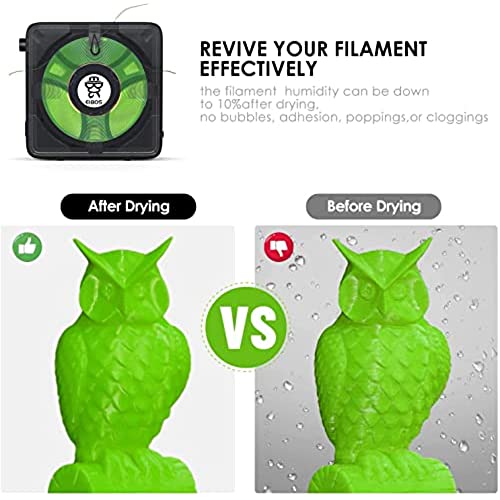
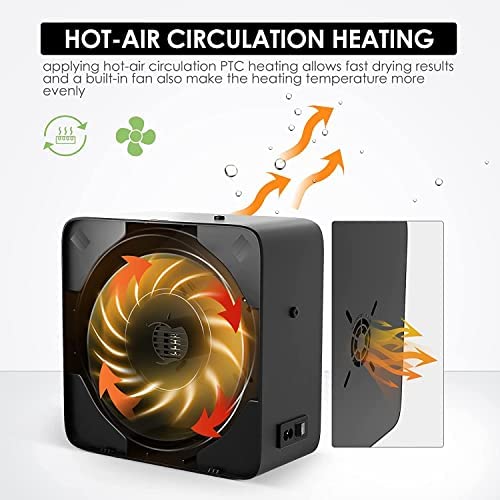
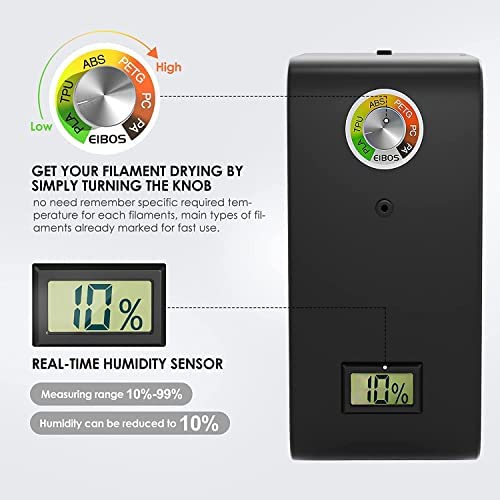
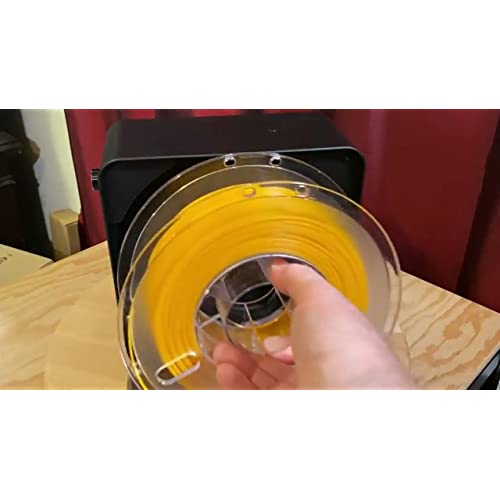







【EIBOS Official】3D Printer Filament Dryer Easdry, 3D Printer Filament Dryer Box with Fan, Adjustable Temperature, Humidity Control & Spool Holder, Compatible with 1.75mm 2.85mm 3.00mm Nylon, PLA, ABS
-

grindmonkey
> 3 dayThis filament dryer has proved to be a filament saver. Our 3D printing business requires us to keep 30+ different colors/materials of filament on hand at any time. Some filaments are used less frequently and tend to stop printing efficiently over time because they start to retain moisture. With this filament dryer, I’m able to dry out older filaments so I can use them when I am ready. What I really appreciate about this dryer is that it has a dial to select different materials (PETG, PLA, TPU, etc.) to dry. As an example, I put in a roll of PETG to dry. It started at 46% humidity, and after two hours, it was at 11% humidity. The dryer was easy to operate and understand. I then used the dried filament to reprint a part that had come out stringy and chunky (see photos). I’m very pleased with the dried filament as it yielded a much cleaner print. In this instance, I rescued about $22 of filament that would have otherwise been recycled. After rescuing a couple of kilos of filament, this dryer pays for itself.
-

Nick
08-06-2025I live in a very humid area and noticed I was starting to have issues with my filament finally, so I decided to pick this up. Not a whole lot to say really, it managed to work exactly as intended going from 81% humidity down to 12%. It’s fairly quiet, works well, and has super simple controls.
-

Oh hey...
> 3 dayThis is a super basic, stripped down filament dryer that works as advertised. The side door opens easily with a convenient pull tab latch, though I did have a couple issues getting the door to seat back in correctly, requiring a couple attempts to get it to seal just right. There are three feeder holes (front, top and back) if you want to run filament straight out of the dryer and into your printer and it comes with a 20 length of PTFE tubing. Around the front it has a humidity gauge, which is quite handy for monitoring internal humidity and a temperature dial where you can select the filament type, so you dont have to remember exact temperatures for each type of filament. Inside, there is a cavity in the front bottom where you can stash desiccant to maintain low humidity after drying and there is a tiny red light to indicate its on at the bottom rear of the window. Around back is a power switch and generic, standard two pin power cable, which is nice in case you ever lose your cable. I dried out a new roll of PETG and set the dial right to the middle of the PETG setting. After about an hour I measured it and got a temperature reading of 65°C, which is right on for the 60-70° you want (though their chart here on Amazon recommends 55-60°, which seems just a tiny bit low). I turned it up to the upper end of the PETG range and later measured 71°C, so it seems to be pretty accurate. Now, what I dont like is that it has no timer or auto off. You have to turn it on and then remember to turn it off manually. My other dryer lets me pick how long I want it to run and shuts itself off, so Ive come to expect this pretty basic feature. I suppose I could just plug it into a smart outlet and set it to shut off there, but thats something that should just be built-in at this price. Overall, its a decent dryer and gets the job done, even if it needs a little more attentiveness to shut it off. The build quality seems nice and the dial makes things simple do pick the correct temperature for any given filament.
-

NorthernVA
> 3 day* For printing environments which benefit from side loading spools, you should consider this printer * detachable power cable is a second benefit over the completions * if you prefer a dial potentiometer to adjust the units drying temperature, this is the unit for you! however… * in my printing environment they didn’t work out + these units require the inside of the filament spool to rotate around a fixed plastic ‘axel’. Bottom rollers as commonly used by other solutions at the same price point at not present. * my experience was that several of my spools of brand new PLA would break off causing overnight jobs to stall * the friction tugging against the filament had other negative impacts of printing * nothing against eibos, just this particular design; as I have to work ‘double roll’ solution with front and back rollers beneath each spool and it works very well. * for fem filament dryers I prefer a digital thermostat with lcd readout ) as is standard on other models) that displays bith the user adjusted target temp and the sampled temp.
-

GB
> 3 dayThis has an easy to use dial to select type of filament you are drying. It comes with extra tubing you can run your filament through to make it pull smoothly. It is vented which allows it to do its job of drying faster. The only minor issue is it drags more than other dryers I have. This puts additional strain on the extruder but probably not much of an issue but optimize your feeding path to keep this as good as you can and watch it. This side loads and you pull down on the strap to release the cover. It was a bit awkward feeding the filament and getting the roll in there but again very minor. Overall I give this 5 stars due to the innovative design. Make it roll easier and it would be optimal. Really everyone should be using a filamanet dryer unless you live where there is no humidity.
-

Mason
> 3 dayGot mine May 19, takes about 2 hours to fully dry a spool. It has nearly been running 24/7 since I got it, not batted an eye yet. Great machine, highly recommend.
-

Rosendo Bartell DVM
> 3 dayThis is a waste of money and time. It arrived scratched. They toss the power plug inside the unit, and it bangs around during shipping, causing damage. The humidity readout isnt even close. It reads over 40%, in the desert, during a dry spell. There are multiple holes to run filament through, but they are all in dumb locations - the filament has to go around corners before it goes throught the holes. This causes friction, which causes printing problems. The sides of the unit get warm, so if you try to use it while printing, your filament will bend and stretch where it comes out. This will cause printing problems. It doesnt work as storage, because its nowhere close to airtight. So, what does this thing do? It does nothing. It is useless.
-

Ethan F.
> 3 dayThis is the best filament dryer I’ve used. I’ve tried 5 different ones and this has them all beat. No shutoff timer! I pretty much print 24/7 and not having to turn it on every few hours is a major deal. Having three sides to output the filament means you have lots of options on placement around your printer. The humidity sensor seems accurate. I like that it is batter powered and the unit does not have to be on to see humidity. The temperature can be dialed in (quite literally) for a range of filament types. I would definitely recommend this dryer! Note: in my photo the one on the left is not turned on. The one on the right has been on for about an hour.
-

Erik
Greater than one weekMost filament dryers do not have a fan, this one does. Seems built very well.
-

Benny
> 3 dayHad 2 prints back to back that uses almost an entire roll of PETG. Placed the roll inside, set to PETG, waited for humidity monitor to read around 10% (new roll and didnt take long at all) then started printing. Roll moved ok (Hatchbox Blue PETG) inside the dryer. No hiccups during almost 3 straight days of printing. Prints came out flawlessly too! Very happy with this dryer. Now I just have to figure out how to store my dried filament. Its a good problem to have.







